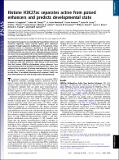Histone H3K27ac separates active from poised enhancers and predicts developmental state
Author(s)
Creyghton, Menno P.; Cheng, Albert W.; Welstead, G. Grant; Kooistra, Tristan G.; Carey, Bryce W.; Steine, Eveline J.; Hanna, Jacob; Lodato, Michael Anthony; Frampton, Garrett M.; Sharp, Phillip A.; Boyer, Laurie; Young, Richard A.; Jaenisch, Rudolf; ... Show more Show less
DownloadBoyer_Histone H3K27.pdf (1.278Mb)
PUBLISHER_POLICY
Publisher Policy
Article is made available in accordance with the publisher's policy and may be subject to US copyright law. Please refer to the publisher's site for terms of use.
Terms of use
Metadata
Show full item recordAbstract
Developmental programs are controlled by transcription factors and chromatin regulators, which maintain specific gene expression programs through epigenetic modification of the genome. These regulatory events at enhancers contribute to the specific gene expression programs that determine cell state and the potential for differentiation into new cell types. Although enhancer elements are known to be associated with certain histone modifications and transcription factors, the relationship of these modifications to gene expression and developmental state has not been clearly defined. Here we interrogate the epigenetic landscape of enhancer elements in embryonic stem cells and several adult tissues in the mouse. We find that histone H3K27ac distinguishes active enhancers from inactive/poised enhancer elements containing H3K4me1 alone. This indicates that the amount of actively used enhancers is lower than previously anticipated. Furthermore, poised enhancer networks provide clues to unrealized developmental programs. Finally, we show that enhancers are reset during nuclear reprogramming.
Date issued
2010-11Department
Harvard University--MIT Division of Health Sciences and Technology; Massachusetts Institute of Technology. Computational and Systems Biology Program; Whitehead Institute for Biomedical Research; Koch Institute for Integrative Cancer Research at MITJournal
Proceedings of the National Academy of Sciences
Publisher
National Academy of Sciences (U.S.)
Citation
Creyghton, M. P., A. W. Cheng, G. G. Welstead, T. Kooistra, B. W. Carey, E. J. Steine, J. Hanna, et al. “Histone H3K27ac separates active from poised enhancers and predicts developmental state.” Proceedings of the National Academy of Sciences 107, no. 50 (December 14, 2010): 21931-21936.
Version: Final published version
ISSN
0027-8424
1091-6490